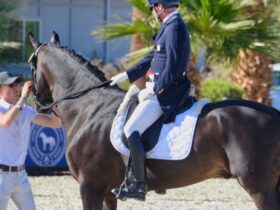Laureen Johnson is the US Equestrian (USEF) Director of Para Dressage and Vaulting. EQ AM had the chance to talk with her about what qualifies someone for a para equestrian classification and the organization’s new Para Centers of Excellence (COEs).
EQuine AMerica: First, can you educate our readers a bit about para dressage in general? How long has it been a USEF sport?
Laureen: To give a little history, the first para dressage competition was at the first Paralympic Games in Atlanta in 1996. So it’s been around for a while.
Would you agree though that, for the average equestrian, it’s not really on their radar? I had no idea it had been around that long.
That is one of our issues. There’s very little known about the program. I am constantly hearing, “I had no idea there was such a program. I’d love to get involved. Can you tell me more about it?”
So let’s work on that… What qualifies someone for the para program?
You have to have a permanent, measurable, physical disability. There are five grades, I-V. Grade V is the least disabled and Grade I is the most disabled. Athletes within a grade compete against each other on a level playing field.
How does a rider become qualified, and at what grade?
To get a national classification, you only need one classifier within your country, the U.S., to give you a bench evaluation and observe you riding. They determine what grade you’re put in. Classifiers are either physical therapists or doctors.
Of course, you can’t compete in international shows without an international classification, so for an international classification, they’re done at the CPDI 3* shows. These are our domestic international competitions, and we will invite a classifier from Europe to come to those competitions. It’s mandatory. And we would have one U.S. classifier as well. So, the individuals would receive a bench testing that’s two classifiers at once, and then be observed by the two classifiers to get the national and international classification. We just had two such events at the Adequan Global Dressage Festival that went very well; USA won the team competition.
Where do riders find horses suitable for para dressage?
Finding a para horse… Well, it is difficult, more difficult than it is for the other disciplines because you have to have a horse with a very sound mind. They must have a sound mind, especially for the lower grade athletes. But, for the lower grade athletes, like Grade I, they compete in walk only. And then, Grade II is walk and trot. So, with each grade, it advances a little bit more. So, for Grade I, you want a horse with a great walk, and that’s actually not that easy to find, believe it or not.
I do believe it. I recently read that the walk is the hardest part of a dressage test. Most people overlook it because they think, “it’s just a walk,” but it’s very severely graded. When I watched the Grade I class at the World Equestrian Games (WEG), I was thinking that those horses must have been pretty strictly evaluated for their walk; otherwise it would make this grade very, very difficult.
So does the rider find their horse? Or, does someone from the para program find the horse and try to match it with the rider?
No, the riders are responsible for finding their own mounts, and then they have them privately evaluated to determine if they are appropriate for para dressage and a good match for that particular para rider. The rider may ask the USEF para coach for his opinion, but generally the riders find their own horses. Some barns may also help their riders find the right para horse if they have a deeper knowledge of para dressage.

(Photo credit Tamara with the Camera)
Is para dressage judged differently than regular dressage?
Yes, that’s the other thing about para-equestrian. While the rider is judged in dressage, judges do not look at the rider in para-dressage; they only look at the way the horse goes. So if a rider has a disability like scoliosis and their back was all crooked, they think, “Oh, I would never qualify because of the way I look on a horse,” but the way they look does not matter: they are not judged on that at all.
I didn’t know that, but that makes perfect sense because para riders can’t really control how they look in the saddle. What really matters is what they can get a horse to perform in spite of their limitations.
What are these knew Centers of Excellence I’ve heard about?
About three years ago, Will Connell, who is from Great Britain and is now our sport director, suggested that we start these COEs within the Professional Association of Therapeutic Horsemanship (PATH) therapeutic riding centers, as they do in Great Britain through what they call “RDA” (Riding for the Disabled Association). The purpose is for the PATH centers to identify talents within their therapeutic riding students. So, for those students that are disabled that want to take on competitive riding, they would work with the COE to get there. The COEs are the primary hubs for delivering the USEF Para-Equestrian Dressage Developing and High Performance Programs, as well as coaching clinics.
Is the COE more of a program, or is actually a delineated place?
PATH centers apply to become a COE. We have certain criteria that they must meet, such as they need to have an arena and the footing needs to be proper for dressage. Having competitive horses is ideal and somebody on staff who does have a knowledge of dressage. Right now we have seven centers. Our goal is to have one in every state so that anybody who may contact us and say, “I’m a disabled person who would love to learn to ride. Where would I go?” We can send them to their closest COE.
Where are the existing COEs located?
- Carlisle Academy (Lyman, ME)
- Contact: Sarah Armentrout, [email protected]
- Healing Strides of VA (Boones Mill, VA)
- Contact: Carol Young, [email protected]
- North Texas Equestrian Center (NTEC) (Wylie, TX)
- Contact: Kai Handt, [email protected]
- Ride On Therapeutic Riding Center (Chatsworth, CA)
- Contact: Megan McQueeney, [email protected]
- Therapeutic Riding, Inc (Ann Arbor, MI)
- Contact: Jennifer Beyer, [email protected]
- Vinceremos Therapeutic Riding Center (Loxahatchee, FL)
- Contact: Susan Guinan, [email protected]
- Wheatland Farm Equestrian Center (Purcellville, VA)
- Contact: Muriel Forrest, [email protected]
Regarding certifying a COE in each state, what’s the status of that endeavor?
We didn’t want to start growing it too quickly because we needed to ensure there were enough appropriately trained coaches and staff, so we started with pilot centers and to see how it would develop, and if there was any success with it. So far it’s going really well and we have three new applications for COE certification that just came in within the last month. We have a panel that will evaluate it and we’ll have someone from the panel go visit the center to make sure it’s safe and that the facility itself is what we’re looking for within USEF parameters. And then, if all goes well, we’ll name them Centers of Excellence.
Where can our readers learn more about COEs?
On our website: https://www.usef.org/compete/disciplines/para-equestrian/para-equestrian-dressage-programs-forms/centers-of-excellence
As an equestrian media outlet focused entirely on American horse sport, EQuine AMerica showcases the USA’s equestrian talent (both two-legged and four) in the disciplines of para dressage, dressage, hunters, jumpers, and eventing. We support and promote our nation’s fantastic equine events, products, services, artists, authors, science/tech, philanthropy, and nonprofits through our online magazine and social media platforms. Our mission is to offer you interesting/inspiring short and long-form content in a format that’s beautiful, readable, and relatable.























SOCIAL